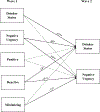The role of parental maladaptive emotion socialization in the risk process for negative urgency and drinking behavior in adolescence
- PMID: 38467519
- PMCID: PMC11586849
- DOI: 10.1002/jad.12312
The role of parental maladaptive emotion socialization in the risk process for negative urgency and drinking behavior in adolescence
Abstract
Introduction: Negative urgency (the tendency to act rashly when experiencing negative emotions) is a robust risk factor for a number of problem behaviors, including early adolescent drinking. Little is known about the factors that precede the development of negative urgency, and hence the full etiology of this component of risk. The current study aimed to investigate the possibility that facets of childhood maladaptive emotion socialization (the tendency for children's expressions of emotions to be met with punishment, minimized, or invoke a reaction of distress from their parents/caretakers) increases risk for the development of negative urgency and drinking behavior.
Method: Self-report measures of negative urgency, subfacets of maladaptive emotion socialization, and drinking behavior were collected during the 2021-2022 academic year from a sample of 428 high school students (mean age = 14.7, SD = 0.09, 44% female), assessed twice over the course of a semester, reflecting a 4-month longitudinal window.
Results: Distress emotion socialization predicted increases in negative urgency, minimizing predicted decreases in negative urgency, and punitive did not provide significant prediction. Additionally, results found that higher levels of both negative urgency and distress emotion socialization increased adolescents' likelihood of having tried alcohol. These processes were invariant across race and gender.
Conclusions: The present study may inform the future creation of prevention and intervention efforts aimed at reducing maladaptive emotion socialization and increasing adaptive emotion socialization. Successful reductions in negative urgency as a consequence of increased adaptive emotion socialization may then lead to decreases in adolescent drinking and other impulsigenic behaviors.
Keywords: adolescent development: affect; adolescent development: personality; adolescent development: risk factors; disturbances and disorders of adolescence: risk behavior and sensation seeking; group or environment: high school students.
© 2024 Foundation for Professionals in Services to Adolescents.
Figures


Similar articles
-
Parental Emotion Socialization of Sadness as a Correlate for Clinical Improvement: A Longitudinal Study of Adolescents with a Range of Nonsuicidal Self-Injury.Res Child Adolesc Psychopathol. 2024 Dec;52(12):1873-1885. doi: 10.1007/s10802-024-01236-3. Epub 2024 Sep 5. Res Child Adolesc Psychopathol. 2024. PMID: 39235520
-
Developmental trajectories of adolescent internalizing symptoms and parental responses to distress.Dev Psychopathol. 2025 May;37(2):603-614. doi: 10.1017/S0954579424000361. Epub 2024 Feb 23. Dev Psychopathol. 2025. PMID: 38389290
-
Parent training interventions for Attention Deficit Hyperactivity Disorder (ADHD) in children aged 5 to 18 years.Cochrane Database Syst Rev. 2011 Dec 7;2011(12):CD003018. doi: 10.1002/14651858.CD003018.pub3. Cochrane Database Syst Rev. 2011. PMID: 22161373 Free PMC article.
-
Behavioral interventions to reduce risk for sexual transmission of HIV among men who have sex with men.Cochrane Database Syst Rev. 2008 Jul 16;(3):CD001230. doi: 10.1002/14651858.CD001230.pub2. Cochrane Database Syst Rev. 2008. PMID: 18646068
-
Brief school-based interventions and behavioural outcomes for substance-using adolescents.Cochrane Database Syst Rev. 2016 Jan 20;2016(1):CD008969. doi: 10.1002/14651858.CD008969.pub3. Cochrane Database Syst Rev. 2016. PMID: 26787125 Free PMC article.
References
-
- Assari S (2021). Association between parental educational attainment and children’s negative urgency: Sex differences. International Journal of Epidemiologic Research, 8(1), 14–22. - PubMed
-
- Atkinson EA, Ortiz AM, & Smith GT (2019). Affective risk for problem drinking: Reciprocal influences among negative urgency, affective lability, and rumination. Current Drug Research Reviews, 12(1), 42–51. - PubMed
-
- Babor TF & Grant M (1989). From clinical research to secondary prevention: International collaboration in the development of the Alcohol Use Disorders Identification Test (AUDIT). Alcohol Health and Research World, 13(3), 71–74.
MeSH terms
Grants and funding
LinkOut - more resources
Full Text Sources
Miscellaneous
